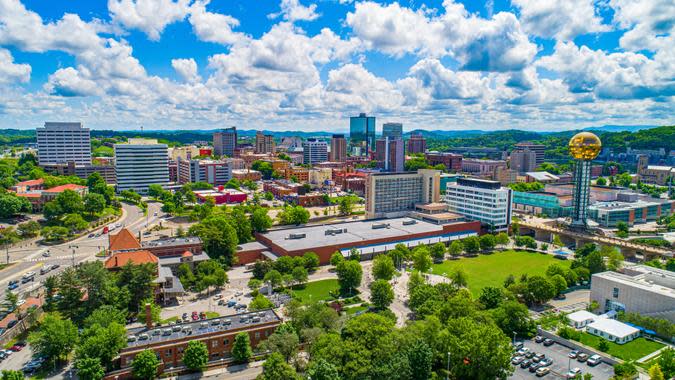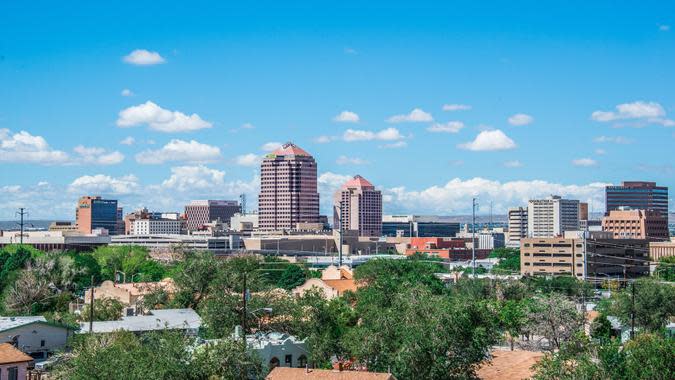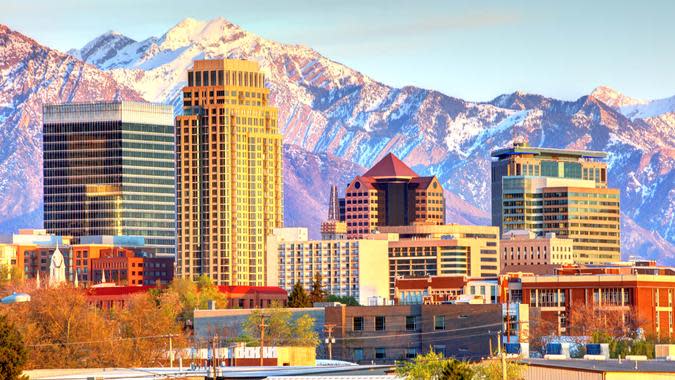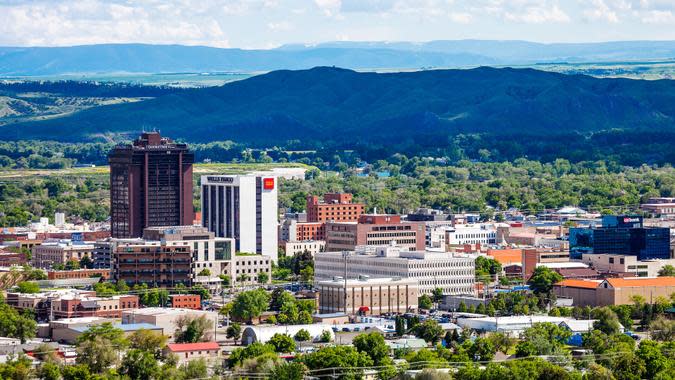Before It Became the Norm, Which States Had the Most Remote Workers?

Along with the rise in unemployment, the U.S. has seen a surge of people working remotely as a result of the coronavirus pandemic. According to a Gallup poll, 62% of employed Americans say they have worked from home during the crisis. Despite the challenges of working from home, these Americans can consider themselves lucky to still have a paycheck coming in during these challenging times.
Related: Companies Hiring For Remote Jobs Right Now
Poll: How Do You Plan To Travel Over the Thanksgiving Holiday?
Even before the coronavirus struck, working remotely was a growing trend in the U.S. An analysis by FlexJobs and Global Workplace Analytics found that the number of people working remotely had grown 44% over the past five years. It had grown 91% over the past 10 years.
That said, remote workers still made up just a small percentage of the overall workforce prior to the crisis that forced employees out of offices and into their homes. Only about 5% of the workforce was working remotely as of the Census Bureau’s 2018 American Community Survey.
However, that percentage varied greatly from state to state, GOBankingRates found. Using Census Bureau data, GOBankingRates identified what percentage of each state’s workforce worked from home. Then it ranked the states from the smallest to the largest percentage of remote workers, with the top state being the one with the largest share of its workforce made up of remote workers.
Most states in the West had a higher percentage of remote workers than the national average of 4.93%. States with a lower percentage of remote workers tended to be in the Midwest and South. In fact, the bottom six states all were in the South.
Now that working remotely has become the norm for more workers, many are reluctant to go back to work in an office. The Gallup poll found that 59% of workers who’ve been doing their jobs from home would like to continue to work remotely as much as possible. As stay-at-home orders are lifted, it will be interesting to see if states that already had a higher-than-average percentage of remote workers will witness that percentage rise even more.
Save: Best Checking Accounts of 2021: High APYs & Low Fees
See if your state is among those where remote work was more commonplace or a rarity. You might find yourself back in an office soon if you live in one of the states expected to bounce back quickly from the coronavirus.
Last updated: Oct. 25, 2021

50. Mississippi
Total number of workers: 1,215,697
Number of remote workers: 27,779
Number of non-remote workers: 1,187,918
Percentage of workforce that worked remotely prior to the coronavirus: 2.29%
Read: 10 Unexpected Work-From-Home Jobs You Can Do Right Now

49. Louisiana
Total number of workers: 2,007,599
Number of remote workers: 60,290
Number of non-remote workers: 1,947,309
Percentage of workforce that worked remotely prior to the coronavirus: 3.00%
Find Out: 22 Side Gigs That Can Make You Richer Than a Full-Time Job

48. Alabama
Total number of workers: 2,051,445
Number of remote workers: 66,881
Number of non-remote workers: 1,984,564
Percentage of workforce that worked remotely prior to the coronavirus: 3.26%
More: 11 Best Lucrative Side Hustle Ideas – Earn More

47. West Virginia
Total number of workers: 727,792
Number of remote workers: 24,213
Number of non-remote workers: 703,579
Percentage of workforce that worked remotely prior to the coronavirus: 3.33%

46. Arkansas
Total number of workers: 1,274,750
Number of remote workers: 43,457
Number of non-remote workers: 1,231,293
Percentage of workforce that worked remotely prior to the coronavirus: 3.41%

45. Kentucky
Total number of workers: 1,929,677
Number of remote workers: 69,702
Number of non-remote workers: 1,859,975
Percentage of workforce that worked remotely prior to the coronavirus: 3.61%

44. Indiana
Total number of workers: 3,107,072
Number of remote workers: 116,603
Number of non-remote workers: 2,990,469
Percentage of workforce that worked remotely prior to the coronavirus: 3.75%

43. Michigan
Total number of workers: 4,504,994
Number of remote workers: 174,997
Number of non-remote workers: 4,329,997
Percentage of workforce that worked remotely prior to the coronavirus: 3.88%

42. Nevada
Total number of workers: 1,351,950
Number of remote workers: 53,538
Number of non-remote workers: 1,298,412
Percentage of workforce that worked remotely prior to the coronavirus: 3.96%

41. Rhode Island
Total number of workers: 515,872
Number of remote workers: 20,430
Number of non-remote workers: 495,442
Percentage of workforce that worked remotely prior to the coronavirus: 3.96%

40. Oklahoma
Total number of workers: 1,748,344
Number of remote workers: 70,248
Number of non-remote workers: 1,678,096
Percentage of workforce that worked remotely prior to the coronavirus: 4.02%

39. Ohio
Total number of workers: 5,442,764
Number of remote workers: 220,315
Number of non-remote workers: 5,222,449
Percentage of workforce that worked remotely prior to the coronavirus: 4.05%

38. South Carolina
Total number of workers: 2,215,014
Number of remote workers: 91,900
Number of non-remote workers: 2,123,114
Percentage of workforce that worked remotely prior to the coronavirus: 4.15%

37. New York
Total number of workers: 9,246,571
Number of remote workers: 389,169
Number of non-remote workers: 8,857,402
Percentage of workforce that worked remotely prior to the coronavirus: 4.21%
Check Out: Companies Hiring for Remote Jobs Right Now

36. Tennessee
Total number of workers: 3,003,226
Number of remote workers: 130,652
Number of non-remote workers: 2,872,574
Percentage of workforce that worked remotely prior to the coronavirus: 4.35%

35. New Jersey
Total number of workers: 4,303,118
Number of remote workers: 188,430
Number of non-remote workers: 4,114,688
Percentage of workforce that worked remotely prior to the coronavirus: 4.38%

34. Nebraska
Total number of workers: 980,914
Number of remote workers: 43,544
Number of non-remote workers: 937,370
Percentage of workforce that worked remotely prior to the coronavirus: 4.44%

33. Kansas
Total number of workers: 1,422,992
Number of remote workers: 63,382
Number of non-remote workers: 1,359,610
Percentage of workforce that worked remotely prior to the coronavirus: 4.45%

32. Wisconsin
Total number of workers: 2,920,388
Number of remote workers: 131,484
Number of non-remote workers: 2,788,904
Percentage of workforce that worked remotely prior to the coronavirus: 4.50%

31. Pennsylvania
Total number of workers: 6,032,013
Number of remote workers: 280,424
Number of non-remote workers: 5,751,589
Percentage of workforce that worked remotely prior to the coronavirus: 4.65%

30. Alaska
Total number of workers: 358,627
Number of remote workers: 16,731
Number of non-remote workers: 341,896
Percentage of workforce that worked remotely prior to the coronavirus: 4.67%

29. Texas
Total number of workers: 12,842,820
Number of remote workers: 604,052
Number of non-remote workers: 12,238,768
Percentage of workforce that worked remotely prior to the coronavirus: 4.70%

28. Maryland
Total number of workers: 3,021,967
Number of remote workers: 142,425
Number of non-remote workers: 2,879,542
Percentage of workforce that worked remotely prior to the coronavirus: 4.71%

27. North Dakota
Total number of workers: 398,937
Number of remote workers: 18,923
Number of non-remote workers: 380,014
Percentage of workforce that worked remotely prior to the coronavirus: 4.74%

26. Illinois
Total number of workers: 6,124,144
Number of remote workers: 290,729
Number of non-remote workers: 5,833,415
Percentage of workforce that worked remotely prior to the coronavirus: 4.75%

25. Iowa
Total number of workers: 1,583,271
Number of remote workers: 75,272
Number of non-remote workers: 1,507,999
Percentage of workforce that worked remotely prior to the coronavirus: 4.75%
Work From Home: The Best and Worst Things About Working From Home

24. Hawaii
Total number of workers: 700,228
Number of remote workers: 33,352
Number of non-remote workers: 666,876
Percentage of workforce that worked remotely prior to the coronavirus: 4.76%

23. Missouri
Total number of workers: 2,855,663
Number of remote workers: 137,750
Number of non-remote workers: 2,717,913
Percentage of workforce that worked remotely prior to the coronavirus: 4.82%

22. New Mexico
Total number of workers: 880,271
Number of remote workers: 42,468
Number of non-remote workers: 837,803
Percentage of workforce that worked remotely prior to the coronavirus: 4.82%

21. Delaware
Total number of workers: 444,908
Number of remote workers: 21,633
Number of non-remote workers: 423,275
Percentage of workforce that worked remotely prior to the coronavirus: 4.86%

20. Virginia
Total number of workers: 4,152,433
Number of remote workers: 207,721
Number of non-remote workers: 3,944,712
Percentage of workforce that worked remotely prior to the coronavirus: 5.00%

19. Massachusetts
Total number of workers: 3,500,223
Number of remote workers: 176,034
Number of non-remote workers: 3,324,189
Percentage of workforce that worked remotely prior to the coronavirus: 5.03%

18. Connecticut
Total number of workers: 1,780,653
Number of remote workers: 90,566
Number of non-remote workers: 1,690,087
Percentage of workforce that worked remotely prior to the coronavirus: 5.09%

17. Wyoming
Total number of workers: 287,175
Number of remote workers: 14,851
Number of non-remote workers: 272,324
Percentage of workforce that worked remotely prior to the coronavirus: 5.17%

16. North Carolina
Total number of workers: 4,660,377
Number of remote workers: 253,038
Number of non-remote workers: 4,407,339
Percentage of workforce that worked remotely prior to the coronavirus: 5.43%

15. Georgia
Total number of workers: 4,667,378
Number of remote workers: 254,502
Number of non-remote workers: 4,412,876
Percentage of workforce that worked remotely prior to the coronavirus: 5.45%

14. Minnesota
Total number of workers: 2,879,806
Number of remote workers: 162,940
Number of non-remote workers: 2,716,866
Percentage of workforce that worked remotely prior to the coronavirus: 5.66%

13. California
Total number of workers: 17,904,213
Number of remote workers: 1,020,810
Number of non-remote workers: 16,883,403
Percentage of workforce that worked remotely prior to the coronavirus: 5.70%

12. South Dakota
Total number of workers: 436,525
Number of remote workers: 25,056
Number of non-remote workers: 411,469
Percentage of workforce that worked remotely prior to the coronavirus: 5.74%

11. Maine
Total number of workers: 651,799
Number of remote workers: 37,525
Number of non-remote workers: 614,274
Percentage of workforce that worked remotely prior to the coronavirus: 5.76%

10. Florida
Total number of workers: 9,140,393
Number of remote workers: 534,519
Number of non-remote workers: 8,605,874
Percentage of workforce that worked remotely prior to the coronavirus: 5.85%

9. Washington
Total number of workers: 3,485,339
Number of remote workers: 207,176
Number of non-remote workers: 3,278,163
Percentage of workforce that worked remotely prior to the coronavirus: 5.94%

8. Arizona
Total number of workers: 3,008,707
Number of remote workers: 182,728
Number of non-remote workers: 2,825,979
Percentage of workforce that worked remotely prior to the coronavirus: 6.07%

7. Idaho
Total number of workers: 757,408
Number of remote workers: 46,006
Number of non-remote workers: 711,402
Percentage of workforce that worked remotely prior to the coronavirus: 6.07%

6. Utah
Total number of workers: 1,433,444
Number of remote workers: 88,266
Number of non-remote workers: 1,345,178
Percentage of workforce that worked remotely prior to the coronavirus: 6.16%

5. New Hampshire
Total number of workers: 707,037
Number of remote workers: 45,262
Number of non-remote workers: 661,775
Percentage of workforce that worked remotely prior to the coronavirus: 6.40%

4. Montana
Total number of workers: 499,849
Number of remote workers: 32,503
Number of non-remote workers: 467,346
Percentage of workforce that worked remotely prior to the coronavirus: 6.50%

3. Oregon
Total number of workers: 1,895,393
Number of remote workers: 129,763
Number of non-remote workers: 1,765,630
Percentage of workforce that worked remotely prior to the coronavirus: 6.85%

2. Vermont
Total number of workers: 321,624
Number of remote workers: 22,275
Number of non-remote workers: 299,349
Percentage of workforce that worked remotely prior to the coronavirus: 6.93%

1. Colorado
Total number of workers: 2,822,072
Number of remote workers: 218,214
Number of non-remote workers: 2,603,858
Percentage of workforce that worked remotely prior to the coronavirus: 7.73%
More From GOBankingRates
Methodology: To find the states with the most remote workers, GOBankingRates used the U.S. Census Bureau's 2018 American Community Survey data on workers aged 16 and older. GOBankingRates pulled data on (1) the total number of workers who worked from home and (2) the total number of workers 16 and over in every state in order to calculate (3) the percent of each state's workforce that worked from home at the time of reporting. States were then ranked on factor No. 3, with the No. 1 state being the one with the largest share of its workforce comprised of remote workers, and No. 50 being the state with the smallest. GOBankingRates also provided the March 2020 unemployment rate in each state from the Bureau of Labor Statistics as supplemental information.
This article originally appeared on GOBankingRates.com: Before It Became the Norm, Which States Had the Most Remote Workers?

